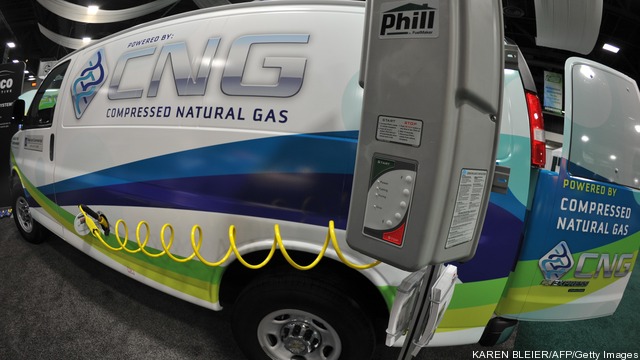
An effort by 22 U.S. states to spur demand for natural gas vehicles has produced a strong response from auto dealers to a request to supply CNG-powered cars, vans and trucks for state fleets.
Dealerships in 28 states representing the three big U.S. manufacturers plus Honda submitted more than 100 bids in response to a joint request for proposals by the states, which are seeking to boost demand for abundant domestic natural gas, and support the price after it fell to a decade-low in spring 2011.
The bids drove down the cost premium of five classes of NGVs compared with their gasoline equivalents, according to the state of Oklahoma, which led the initiative with Colorado, and buys 500 – 750 fleet vehicles a year.
Demand for the vehicles, at a time when a gasoline gallon equivalent of CNG is selling for about a third of that for gasoline, cut the premium for the five vehicle classes by between 4 and 16 percent, according to results of the bidding process, released on Oct. 4 and 5.
The announcement represents a key component of the movement towards American energy independence,” – Colorado Governor John Hickenlooper
Officials say the successful RFP will encourage the auto industry to make more CNG vehicles, further reducing prices and stimulating public demand for abundant domestic shale gas at a time when policymakers are seeking to build energy independence while reducing carbon emissions.
“The initiative has been enormously successful,” said Oklahoma Governor Mary Fallin, in a statement. “We asked auto manufacturers to develop products that were more affordable and functional. With the combined purchasing power of our 22 states, we successfully provided the incentive to do so. States will now have the incentive and the ability to begin converting their fleets to CNG while saving millions of dollars in taxpayer money.”
Jay Albert, Okahoma’s deputy secretary of energy, said demand for the vehicles has reduced the price of a three-quarter ton Dodge Ram truck converted to run on CNG by about $6,000 from its 2011 price to just under $30,000.
With CNG now at about $1.35 per GGE in Oklahoma – compared with $3.63 a gallon for gasoline – the reduced purchase price will allow the owner of the converted Dodge Ram driving 15,000 miles a year to pay off the premium in two and a half years, about half the previous time, Albert said.
Larger Municipal Fleets to Help Spur Fueling Infrastructure Development
After recouping CNG system costs, that truck would cost about $20,000 a year less to operate by using CNG than it would when powered by gasoline, according to Oklahoma calculations.
For a compact sedan, the CNG premium declined by 8 percent, or about $2,100.
Albert predicted that the increased presence of NGVs in state, city and local government fleets will encourage the growth of refueling infrastructure, whose relative scarcity is a major obstacle to widespread public acceptance of CNG-powered vehicles.
Frank Dankovich, Head of Government Sales for Chrysler Group Fleet division, said the bids indicate strong demand for NGVs from government, and predicted that demand will spur more declines in NGV premiums and further investment by the auto industry.
That’s likely to mean more availability to the public, he wrote in an email. “OEMs [Original Equipment Manufacturers] will continue to invest in NGVs if the market continues to indicate a real demand for the products and the investment in infrastructure continues to accelerate thereby providing a viable fueling option to prospective customers.”
Oklahoma, a leading natural gas producer, currently has 63 public CNG filling stations, the most per-capita of any U.S. state, helping to explain its ability to sell CNG at a price well below the national average of about $2 per GGE, Albert said.
But Pennsylvania, which also joined the NGV initiative, has only 11 public CNG filling stations, according to its former environment secretary, John Hanger, despite sitting atop the Marcellus Shale, the most productive U.S. shale gas field.
The bids result from a bipartisan memorandum of understanding initially signed by four gas-producing states in 2011 in an effort to convert more of their vehicle fleets to natural gas and persuade automakers to meet increased demand which they hope will eventually come from the public as well as from state and local government.
“The announcement represents a key component of the movement towards American energy independence,” said Colorado Governor John Hickenlooper. “We believe this is the start of a national movement to add much-needed fuel diversity to our nation’s transportation sector.”
